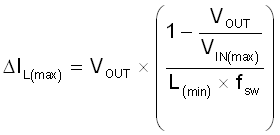SLVAF55 July 2021 TPS62130 , TPS62901 , TPS62902 , TPS62903
4.2 Automatic Efficiency Enhancement (AEE™)
The AEE™ feature in the TPS6290x provides highest efficiency over the entire input voltage and output voltage range by automatically adjusting the converter's switching frequency when 2.5MHz is selected. This is achieved by setting the predictive off-time of the converter. The efficiency of a switched mode converter is determined by the power losses during the conversion. The efficiency decreases when VOUT decreases and or VIN increases. In order to keep the efficiency high over the entire duty cycle range (VOUT/VIN ratio), the switching frequency is adjusted while maintaining the ripple current. Equation 2 shows the relationship between the inductor ripple current, switching frequency and duty cycle.

Efficiency increases by decreasing switching losses and by preserving high efficiency for varying duty cycles while the ripple current amplitude remains low enough to deliver the full output current without reaching current limit. The AEE™ feature provides an efficiency enhancement for various duty cycles, especially for lower Vout values, where fixed frequency converters suffer from a significant efficiency drop. Furthermore, this feature compensates for the very small duty cycles of high VIN to low VOUT conversion, which limits the control range in other topologies.